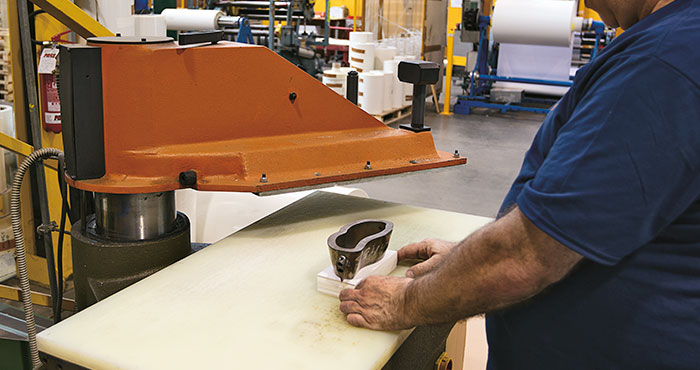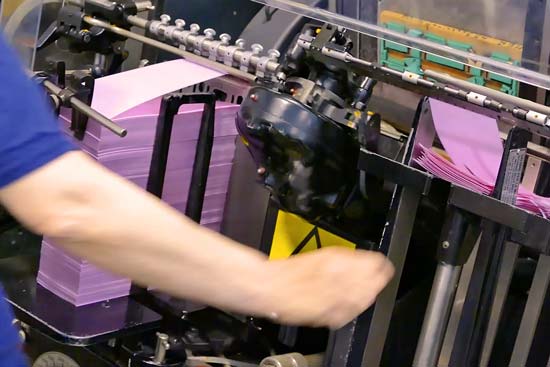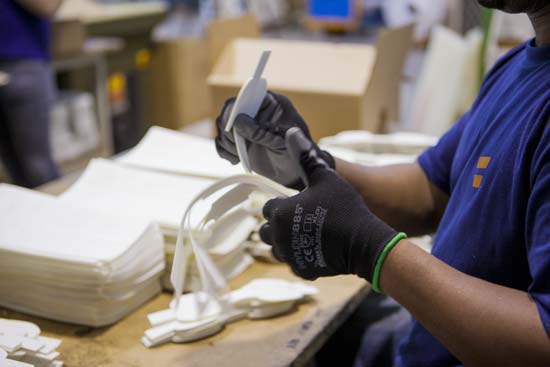
Die-Cutting



Die-cutting is a particular cutting process that is performed using a special steel blade with a sharp profile (die), shaped according to the profile to be created. Unlike the cutter whose work is done orthogonally, the die allows shapes to be made along broken and curved lines. This process therefore allows flexible materials to be cut into pieces of different shapes.
This equipment from Filmcutter has been developed over time mainly for the production of "phase separators" for electric motors and has then been extended to the production of more complicated and articulated pieces for various applications.
The department is equipped with automatic, rotary, and step die-cutting machines, in addition to sheet cutting machines, vertical blade cutters, and vertical presses. This equipment allows us to offer customers the widest range of die-cut pieces in materials of different thicknesses, thermal classes, and dielectric rigidity.
The die-cut pieces can be produced in maximum dimensions of approximately 500 mm x 500 mm, while in the case of sheet cutting, the dimensions can be even larger, reaching a maximum width of 1000 mm.
Execution
Die-cutting is an essential and highly specialized process in the manufacturing industry, particularly widespread in the processing of paper, plastic, and other flexible materials. This process, also known as die cutting, involves using a die or mold to cut and shape sheet or roll materials into specific and precise shapes. This method is used for the production of a wide range of products, including packaging, labels, cards, gaskets, products for the textile sector, and much more.
The process consists of several stages that require technical skills and specialized equipment. Initially, a die is created, which is a precisely shaped piece of metal that corresponds to the desired shape for the final product. This die can be made through a series of methods, including laser cutting, CNC milling, or wire EDM. The precision and quality of the die are crucial to ensure accurate and repeatable cutting results.
Once the die is created, the material to be cut is fed through a die-cutting machine, which uses the die to perform the cut according to the desired specifications. These machines can be of various types, including flatbed die-cutters, rotary die-cutters, or cylinder die-cutters. Depending on production needs, other cutting techniques such as pressure cutting, knife cutting, or ultrasonic cutting may also be used.
Main Benefits
Die-cutting offers several significant advantages for manufacturers. First of all, it allows for finished products with precise and repeatable shapes, ensuring uniformity and consistency in mass production. This is particularly important for sectors such as packaging, where the presentation and functionality of the product depend on the precision of the cut shapes. Additionally, it allows for products with intricate and complex details that would be difficult or impossible to achieve with other processing methods.
Another advantage is its versatility. This process can be used to cut a wide range of materials, including paper, cardboard, plastic, rubber, fabric, and much more. Furthermore, it can be employed to produce a variety of shapes and sizes, allowing manufacturers to meet a wide range of design and application needs. This flexibility makes die-cutting an ideal choice for many industries and sectors.
This process also offers a high degree of efficiency and speed in production. Modern die-cutting machines can perform quick and precise cuts on large quantities of material in a short amount of time, allowing manufacturers to reduce production times and increase overall productivity. This is particularly important in a competitive environment where quick delivery times and the ability to promptly respond to customer demands are crucial for business success.
Finally, die-cutting can help reduce material waste and optimize production process efficiency. By using custom dies and optimizing the layout of cutting patterns, manufacturers can maximize material utilization and minimize waste. This not only helps improve the environmental sustainability of manufacturing operations but can also reduce overall production costs and improve business profitability.
In conclusion, die-cutting is an essential and highly specialized process that offers several significant advantages for manufacturers of a wide range of products. From precision and consistency in cut shapes to versatility and production speed, it is a fundamental technique for efficiently and effectively achieving high-quality finished products. With the continuous development of new technologies and materials, die-cutting will continue to play a crucial role in the manufacturing industry, contributing to the growth and success of businesses worldwide.

